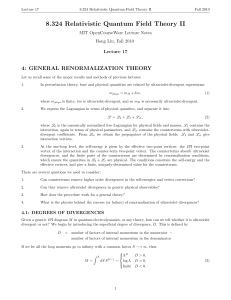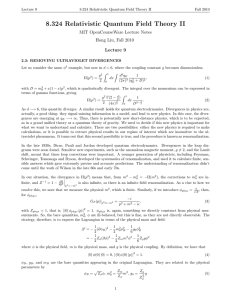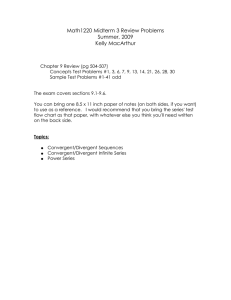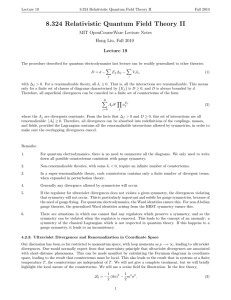8.324 MIT OpenCourseWare Lecture Notes Hong Liu, Fall 2010 Lecture
advertisement
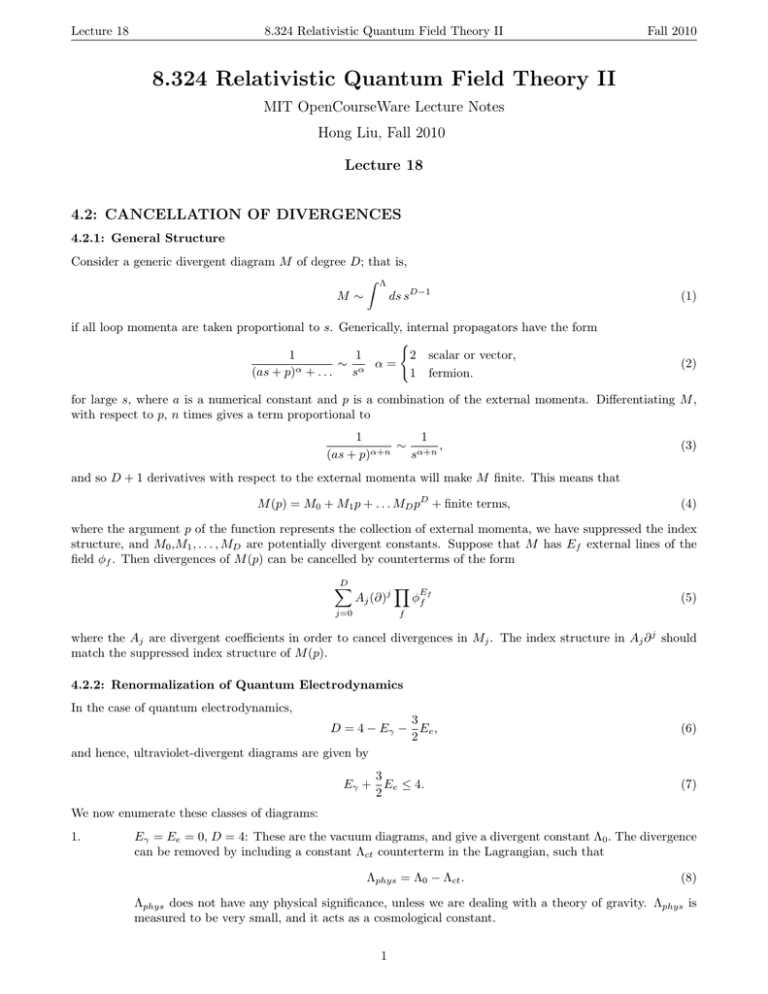
Lecture 18
8.324 Relativistic Quantum Field Theory II
Fall 2010
8.324 Relativistic Quantum Field Theory II
MIT OpenCourseWare Lecture Notes
Hong Liu, Fall 2010
Lecture 18
4.2: CANCELLATION OF DIVERGENCES
4.2.1: General Structure
Consider a generic divergent diagram M of degree D; that is,
ˆ �
M�
ds sD−1
if all loop momenta are taken proportional to s. Generically, internal propagators have the form
{
2 scalar or vector,
1
1
� � α=
(as + p)� + . . .
s
1 fermion.
(1)
(2)
for large s, where a is a numerical constant and p is a combination of the external momenta. Differentiating M ,
with respect to p, n times gives a term proportional to
1
1
� �+n ,
�+n
(as + p)
s
(3)
and so D + 1 derivatives with respect to the external momenta will make M finite. This means that
M (p) = M0 + M1 p + . . . MD pD + finite terms,
(4)
where the argument p of the function represents the collection of external momenta, we have suppressed the index
structure, and M0 ,M1 , . . . , MD are potentially divergent constants. Suppose that M has Ef external lines of the
field ϕf . Then divergences of M (p) can be cancelled by counterterms of the form
D
∑
Aj (∂)j
j=0
∏
E
ϕf f
(5)
f
where the Aj are divergent coefficients in order to cancel divergences in Mj . The index structure in Aj ∂ j should
match the suppressed index structure of M (p).
4.2.2: Renormalization of Quantum Electrodynamics
In the case of quantum electrodynamics,
3
D = 4 − E� − Ee ,
2
and hence, ultraviolet-divergent diagrams are given by
3
E� + Ee � 4.
2
(6)
(7)
We now enumerate these classes of diagrams:
1.
E� = Ee = 0, D = 4: These are the vacuum diagrams, and give a divergent constant Λ0 . The divergence
can be removed by including a constant Λct counterterm in the Lagrangian, such that
Λphys = Λ0 − Λct .
(8)
Λphys does not have any physical significance, unless we are dealing with a theory of gravity. Λphys is
measured to be very small, and it acts as a cosmological constant.
1
Lecture 18
8.324 Relativistic Quantum Field Theory II
Fall 2010
2.
Ee = 1, E� = 0, 1, 2 and Ee = 0, E� = 1: These terms are all zero because of Lorentz invariance.
3.
Ee = 0, E� = 2, D = 2: This is the photon self-energy,
е� (q) =
µ
�
q
.
(9)
Expanding this term, we get
Πµ� (q) = c1 η µ� + c2 q 2 η µ� + c3 q µ q � + finite terms.
(10)
The Ward identity imposes
Πµ� (q) = q 2 PTµ� (q)Π(q 2 ),
(11)
Π(q 2 ) = C + finite terms
(12)
and so we have
where C is the only divergent constant. The divergence in C can be absorbed in the counterterm vertex,
= (Z3 − 1)F µ� Fµ� .
p
(13)
4.
Ee = 0, E� = 3, D = 1: This is zero by charge conjugation invariance, as will be shown on the problem
set.
5.
Ee = 0, E� = 4, D = 0: This is the four-point vertex,
µ
Mµ�αγ
�
�
�
�
=
K(ηµ� ηαγ − ηµα η�γ + ηµγ η�α ) + finite terms,
(14)
where K is a potentially divergent constant, and the form of the divergent term follows from symmetry.
The Ward identity constrains that
q µ Mµ�αγ = 0,
(15)
and so K = 0, and the four-point vertex is convergent.
6.
Ee = 2, E� = 0, D = 1: This is the fermion self-energy,
Σ(k)
�
=
A + Bk/ + finite terms.
(16)
Here, A and B are divergent constants, and they can be cancelled by the counterterm vertex,
= (Z2 − 1)(ik/ − m) + Z2 δm,
(17)
k
with the mass renormalization δm and the field strength renormalization Z2 chosen appropriately.
7.
Ee = 2, E� = 1, D = 0: This is the vertex function,
Γµ (k, k ′ ) = Aγ µ + finite terms.
2
(18)
Lecture 18
8.324 Relativistic Quantum Field Theory II
Fall 2010
where A is a logarithmically divergent coefficient. This can be cancelled by the counterterm three-point
vertex,
¯ µ ψ,
= −Z1 eAµ ψγ
(19)
where the Ward identity imposes Z1 = Z2 .
In summary, the counter terms we considered before are enough to cancel all of the superficial divergences to all
orders in perturbation theory. We still need to consider diagrams with divergent sub-diagrams. Generically, these
can be easily cancelled since divergent sub-graphs must also belong to those considered above. For example, the
pairings
+
,
+
(20)
are both finite. We now need to consider the case of overlapping divergences. That is, when two divergent subgraphs
share an internal line. These divergences are more difficult to deal with. For example, consider the diagram
p′ + q
p+q
µ
p − p′
q
�
q
.
(21)
p′
p
In the case that p is taken to be large, the pairing
q
q
µ
�
+
(22)
p′
gives a vertex correction at the vertex µ, leaving a residual self-energy divergence for the case p′ −≡ ≤. Similarly,
if p′ is taken to be large, the pairing
q
q
µ
�
+
(23)
p
gives a vertex correction at the vertex ν, leaving a residual self-energy divergence for the case p′ −≡ ≤. The two
procedures are not independent, and it is finally necessary to add a correction of the form
(24)
3
Lecture 18
8.324 Relativistic Quantum Field Theory II
Fall 2010
at the order O(e4 ) to cancel the divergences when both p and p′ are large. Another example is given by the
combination of diagrams
p′
p′
+
+
+
.
(25)
p
p
It can be proved to all orders, the content of the Bogoliubov-Parasiuk-Hepp-Zimermann theorem, that overlapping
divergences can be canceled by counterterms corresponding to superficial divergences.
4
MIT OpenCourseWare
http://ocw.mit.edu
8.324 Relativistic Quantum Field Theory II
Fall 2010 For information about citing these materials or our Terms of Use, visit: http://ocw.mit.edu/terms.
